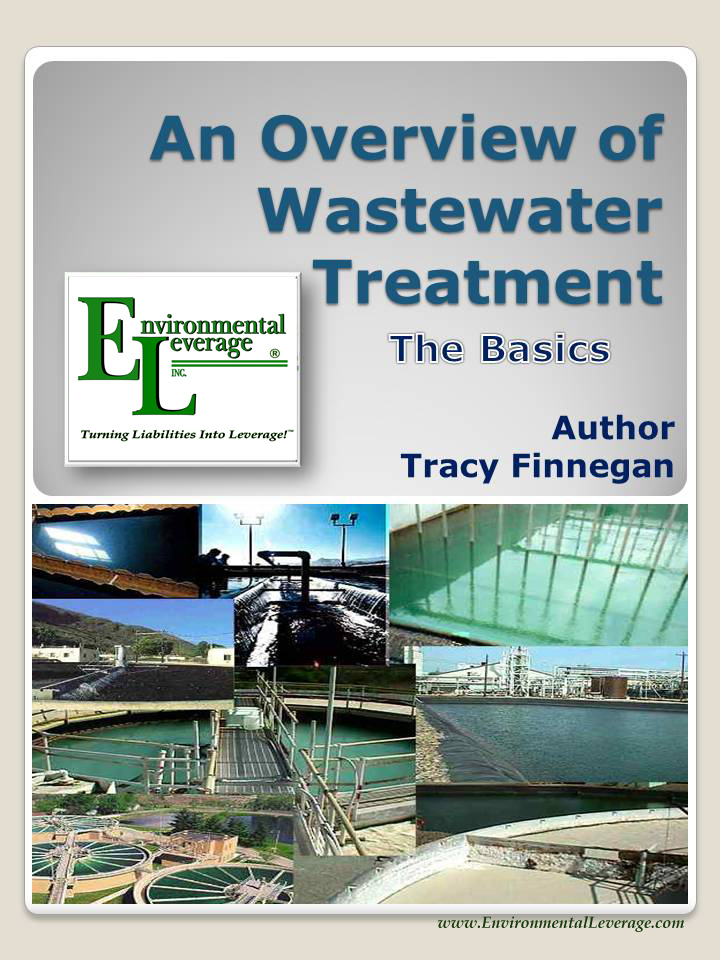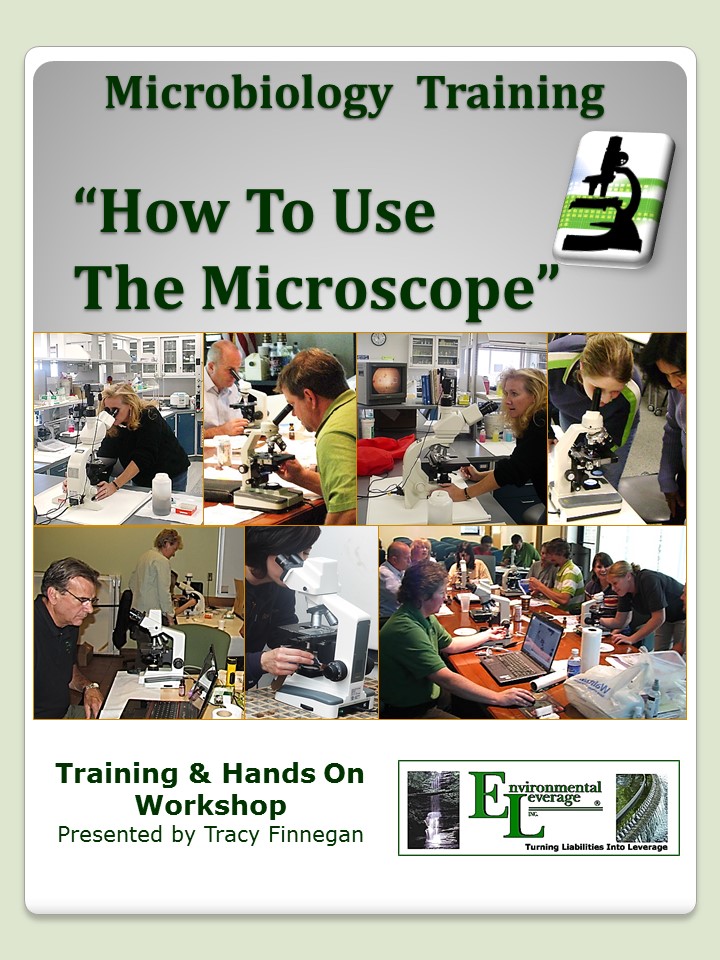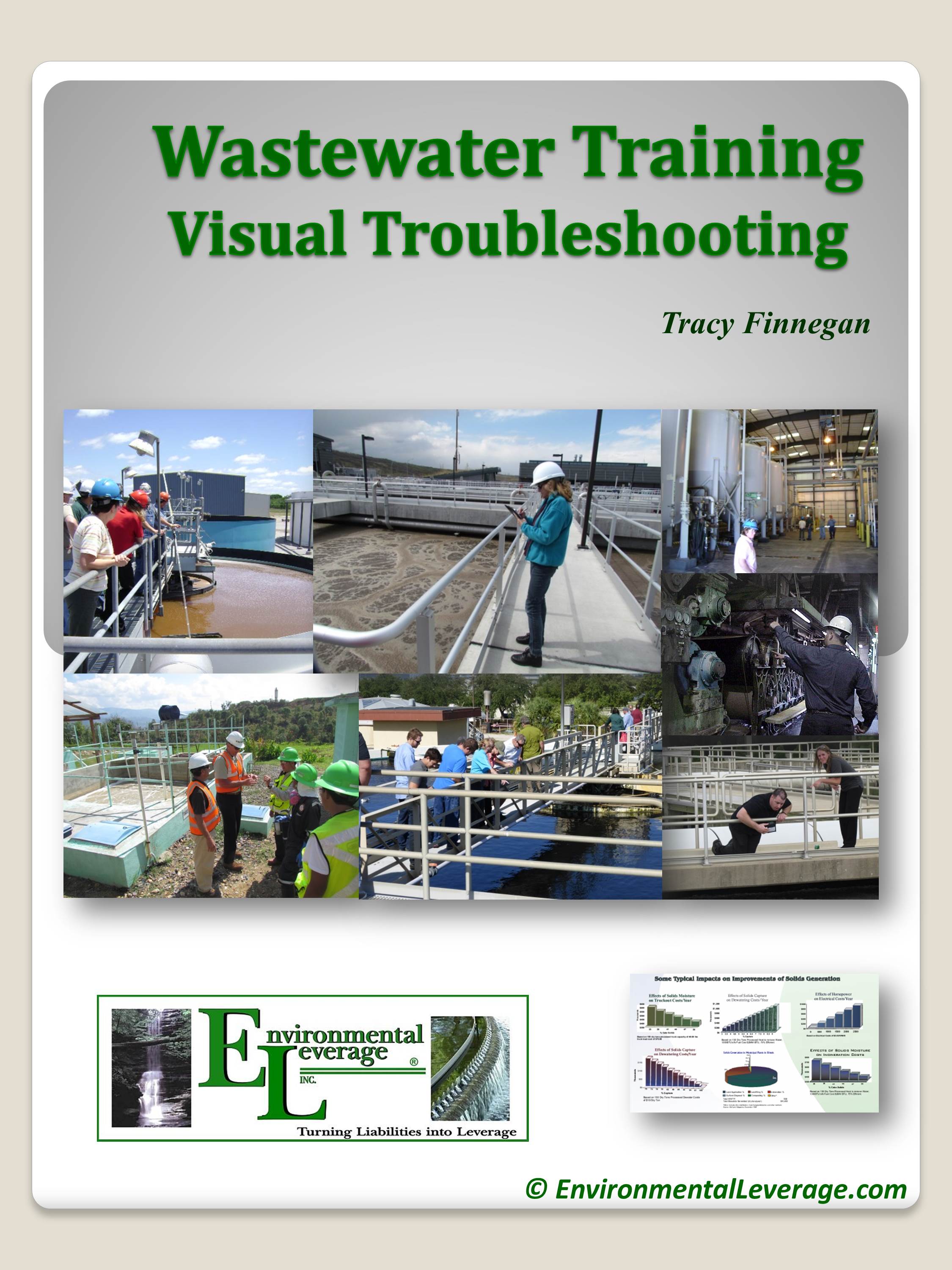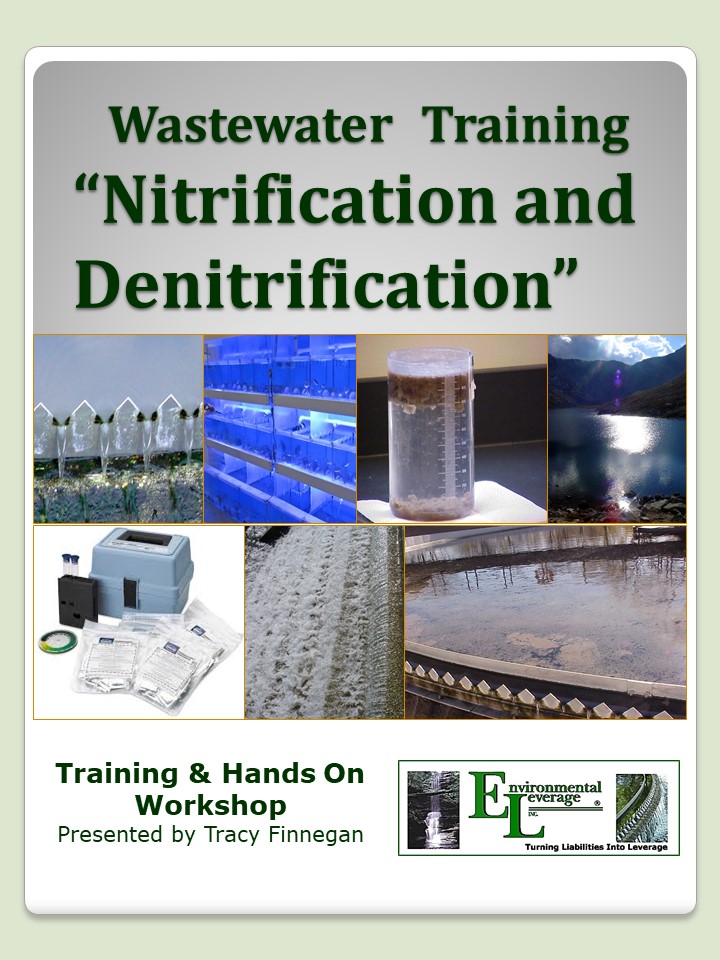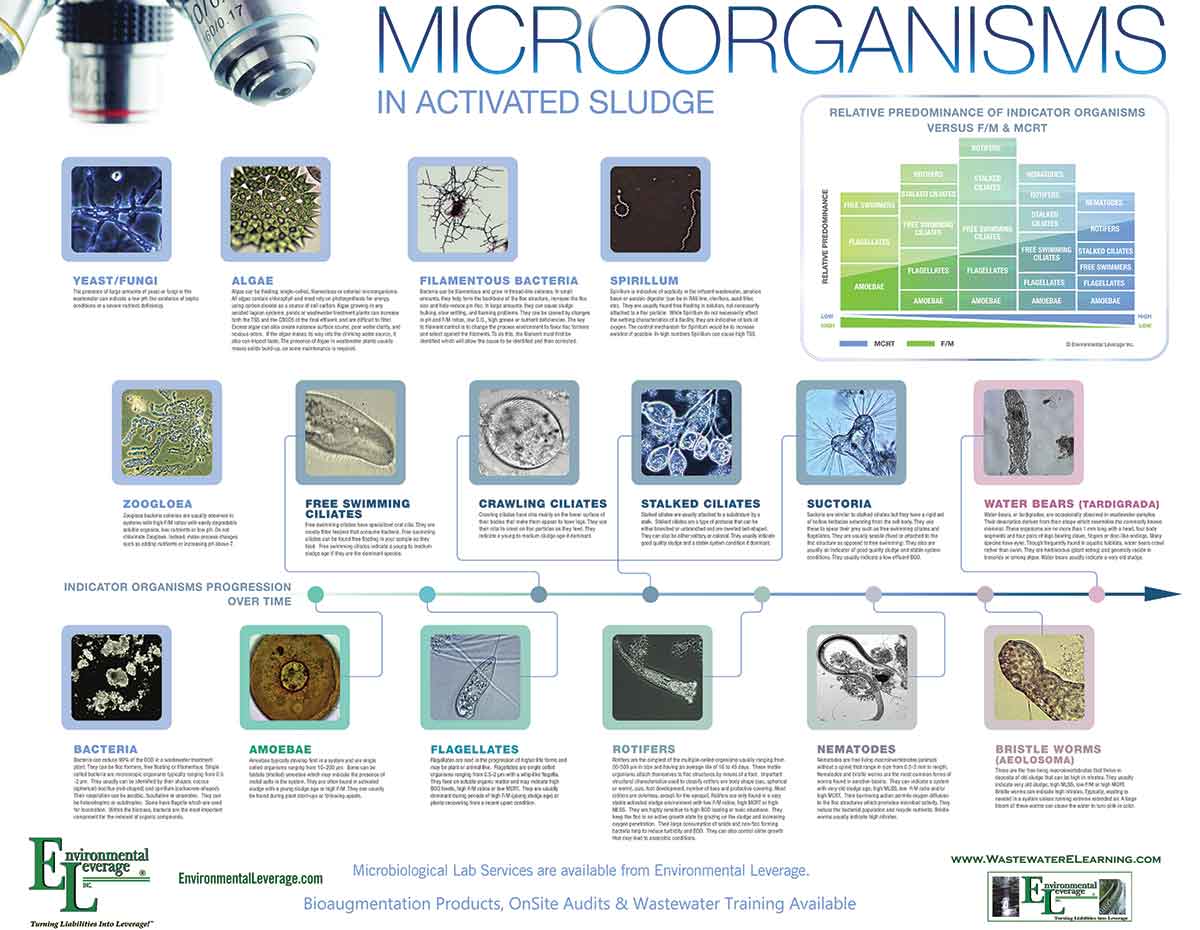Biological Products:
Bioaugmentation products for Wastewater applications in Papermills, Refineries, Chemical, Tanneries, Municipalities, Textiles, Steel, Agriculture, Animal feedlot, Gun Powder plant, Food and Beverage- Dairy Products, Orange Juice factory, Wineries, Cookie factory, Vegetable processing plant, Meat packing, Barbecue Restaurant, Aquaculture, Ornamental Ponds for algae control, CAFO, Nursing homes, Military, Campgrounds, Universities, Regulatory agencies
Lab Services:
Filamentous Identification Lab Service. One reason to identify filaments is to determine the filaments characteristics and then determine the type present. If the type is found out, a root cause can usually be associated with a particular filament. If the cause is known, then a correction can be made to alleviate problems. Chlorination is only a quick fix. Without process changes, filaments will grow back after chlorination. Wastewater Biomass Analyses and Cooling Tower Analyses also available
Training Materials:
Training is an integral part of any job. Not everyone is at the same level of training. Many people want beginning concepts and basics. Some need technical information or troubleshooting. Some want equipment, technology or process information. We have developed a full set of Basic training, Advanced training, Filamentous Identification the Easy Way as well as custom training CD's Manuals. We also provide hands-on training classes and soon will have an Online "E-University".
Audits and Consulting:
At Environmental Leverage® Inc., we have a team of experienced individuals who come into your plant with a fresh pair of eyes. The system is checked from influent to effluent. System optimization, equipment efficiency and operational excellence are key components explored. Key Benefits Equipment efficiency Total Cost of Operation reductions Reliability and safety An onsite audit is conducted to examine system parameters, process controls, and current monitor and control procedures. A physical walk-through is conducted, process flow diagrams are examined, previous design criteria are examined and current standard operating procedures are evaluated along with data logs.
|
SteelWhat's New!
We have just added "Virtual Audits" to our capabilities. Check out our new Services. We are in the process of developing new courses for our ""Online E-University" in order to meet the needs of our global customers that cannot travel to our public classes.Visit our new website www.WastewaterElearning.com/Elearning
Typical Steel Mills use acids in the pickling process. There are a ton of companies now that can help them reuse and regenerate the spent acid. After final use though, depending upon the concentration of metals present, this acid may also be used for pH adjustment at other waste treatment plants. Oily sludge is generated and usually sent off to waste haulers at significant costs. There are alternatives to this also depending upon the plant, the types of cokers, blast furnaces, EOF's or BOF's, and metals present.
Steel is one of nine energy- and waste- intensive industries that is participating with the U.S. Department of Energy's Office of Industrial Technologies in a new collaborative R&D strategy called "Industries of the Future." http://www.oit.doe.gov/steel/
The steel industry (including iron production) is one of the largest energy consumers in the manufacturing sector and has invested more than $7 billion in environmental controls. Steel is the most recyclable and recycled material in North America, with an overall recycling rate of 68 percent.
Recycling
Water usage at a steel mill can be high. Boiler and Cooling Tower Blowdown Oil and Grease- What is it and how to get rid of it Sign up to receive our Monthly Email Newsletter and be ahead of the curve!
EPA Office of Compliance Sector Notebook Project, Steel Industry. More information can be obtained on the EPA website http://es.epa.gov/oeca/sector or
by
contacting Environmental Leverage
Key Inputs and Outputs Key inputs include boiler feedwater, condensate returned, water treatment chemicals and air/oxygen input. Key outputs include steam mass flowrate, steam pressure, steam quality, combustion gas conditions.
The Average Solids Generation Ratio To Use As Benchmark in a wastewater
treatment plant for sludge:
MicroSolv 410 can be used to help biological problems at a steel mill.
Areas in a wastewater treatment plant that can be optimized: With all the Green Grants and interest in alternative fuel sources,
recovery and reuse of spent oils has grown Algae on weirs can lead to TSS violations in final effluent Scalping tank can be optimized Solids build-up on scrapers of DAF Sludge Thickener Clarifier with too many solids and gassing Oil slicks near clarifier burping up can lead to permit violations Oil can be sold to waste haulers to be re-used as fuel instead of being charged disposal fees
Boiler and Cooling Tower Blowdown Case History-Tank Remediation at a PetroChemical Plant
It does not really take long depending upon how much you seed the tank with.
And the bacteria grow and multiply exponentially, so just sit back and wait.
You wind up with a clean tank, clear effluent, and some bacteria residuals
on the bottom of the tank that need to be disposed of- ( usually sent to the
plants onsite dewatering system) or land applied.
Plant Issues 900 m3 of Contaminated Soil. Pollution: Crude oil. Several option where evaluated and E. H. Green/Environmental Leverage bioaugmentation program solution was elected. Due to the Hydrologic Area which the plant is located in ,the EPA of Israel instructed the plant to move the soil or reduce the TPH ( Total petroleum Hydrocarbons) from 842 to 100 ppm. Initial proposal assumed that it would take a few months due to high heat in the summer, and mainly the amount of soil and contamination to treat. After two weeks, TPH was down to 311, the following week, 133. Final TPH levels were pulled at 4 locations- 38, 39,81 and 37 were the final TPH readings, ~90-95.6% reduction in TPH ( Total petroleum Hydrocarbons) 80% cost reduction in treating the soil biologically including labor, nutrients, biological products, etc vs. hauling out the dirt as hazardous waste~ Soil Remediation Case History- Total Petroleum Hydrocarbons
In order to "Audit" or Troubleshoot a Steel Mill wastewater treatment plant, a number of things need to be looked at. A physical walk-through of the plant needs to be conducted with visual observations noted. A microscopic analyses of the Biological portion of the waste treatment system needs to be conducted. Settleometer Testing needs to be conducted A sludge judge should be used on a Clarifier Examination of lab data- current testing procedures and results Walk through and correlation of process side to wastewater treatment plant operations A fully detailed final report is issued with process recommendations, system changes, areas for optimization and increased efficiency. For a full onsite audit of your plant- Contact Environmental Leverage inc. 630-906-9791
More troubleshooting for Refineries and Petrochemical plants: Troubleshooting Lagoon Systems
For a full onsite audit of your plant- Contact Environmental Leverage inc. 630-906-9791
Bioaugmentation for reduction of BOD and TSS
Troubleshooting Lagoon Systems Wastewater in the Fall- Problems and Solutions Beneficial Reuse Lagoons-Winter BOD issues and bioaugmentation Learn how Environmental Leverage can help your plant Bioaugmentation in Steel Mills impact on BOD and TSS Filamentous bacteria can be a problem is solids are held too long in a clarifier also. Total System Optimization- Case History Lab Testing and Troubleshooting Newsletter More to come . . . . .
Wastewater Training Options The greatest equipment and the most efficient, dedicated workers can be ineffective if they are not properly trained. At Environmental Leverage, we have years of experience in many process areas and technical expertise on equipment, systems and operations. Programs to optimize your system or custom training can be tailored to increase the reliability and efficiency of your plant. Look for self taught training materials and training courses below.
We have developed a full line of Training CD's and Elearning classes for training and operator CEU's.
Elearning and General Brochure Click for brochure Online Wastewater Training ELearning -Since wastewater training is such an integral part of any treatment system, we have been asked
to develop an online waste water training program with some of our materials.
Click here and Go straight to our WebSite - www.WastewaterELearning.com Take a sneak peek inside our training courses with our ELearning Demo Make sure to create an account and log in. Lab Poster
Environmental Leverage Lab Poster for Wastewater Training. This Microbiology Poster has photos as well as descriptions and troubleshooting recommendations of common micro organisms found in most wastewater treatment plants.
Contact Environmental Leverage for more
information about obtaining this poster for your lab or setting up hands on
training, consulting and onsite audits.
|

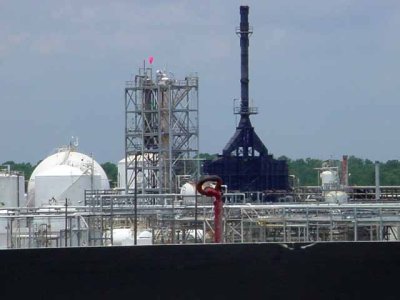
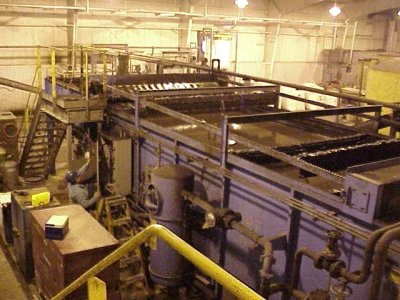 by-products in spent NO3-HF pickle liquor.
by-products in spent NO3-HF pickle liquor.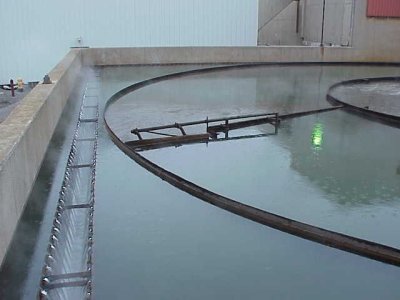 There are tons of files containing information on every subject from A to
Z on the internet with standards, benchmarks and industry BMP's. The
problems is, who has time to dig and find it all. It is not always in easy
to find places. We have tried to show you some of the ones we though
might be useful. There are links to the places where we found some of them
in case you want to dig deeper on a particular subject and find out more.
There are tons of files containing information on every subject from A to
Z on the internet with standards, benchmarks and industry BMP's. The
problems is, who has time to dig and find it all. It is not always in easy
to find places. We have tried to show you some of the ones we though
might be useful. There are links to the places where we found some of them
in case you want to dig deeper on a particular subject and find out more.

